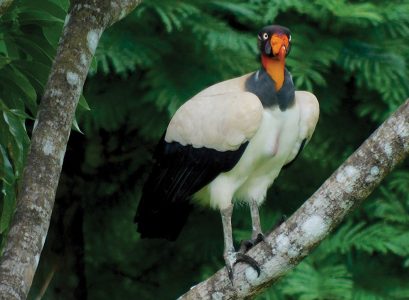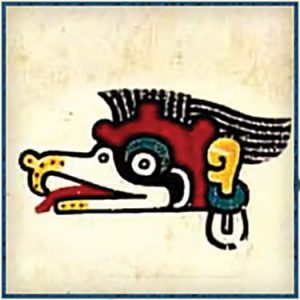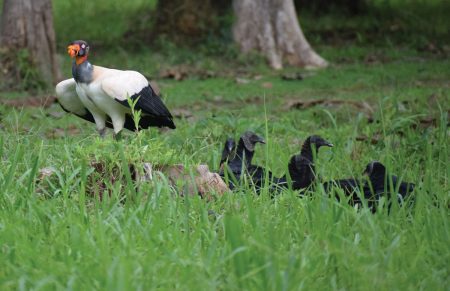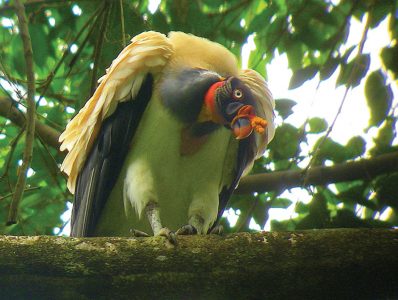King of the Jungle
 Riding along the edge of the forest on horseback I caught a whiff of something rotten, and a moment later a big, beautiful, black and white bird with a multicolored head came into view. It was pecking away at the stinking carcass of a dead opossum. There was a bunch of black vultures hopping around nearby mostly just watching, but occasionally darting forward and snatching a morsel of the decomposing flesh and quickly withdrawing. All kept their distance from the magnificent creature which calmly ate its fill paying little attention to the others.
Riding along the edge of the forest on horseback I caught a whiff of something rotten, and a moment later a big, beautiful, black and white bird with a multicolored head came into view. It was pecking away at the stinking carcass of a dead opossum. There was a bunch of black vultures hopping around nearby mostly just watching, but occasionally darting forward and snatching a morsel of the decomposing flesh and quickly withdrawing. All kept their distance from the magnificent creature which calmly ate its fill paying little attention to the others.
 “What is that beautiful white bird?” I asked Orlando. “The zopilotes sure give it plenty of space.”
“What is that beautiful white bird?” I asked Orlando. “The zopilotes sure give it plenty of space.”
“Of course they do,” replied Orlando, a slight smile on his face. “He’s the king. We call him El Rey de Zopilotes (King of the Vultures).”
“I never knew a vulture could be so beautiful?” I blurted out in amazement. “I can see why you call him the king.”
 Throughout history the king vulture (Sarcoramphus papa) has been recognized as a very special being. The Mayas considered it to be a god and believed that it carried messages between other gods and humans. This comes from the codices which are folding books that were written by Maya scribes on bark paper, and in which were recorded the vast accumulation of Maya knowledge and religion. The arrival of the Spanish conquistadores and the priests who accompanied them brought the destruction of most of the codices. Thousands were destroyed, and only four survived. The codex that describes the king vulture was one of the one of the four. The magnificent bird was represented with this glyph:
Throughout history the king vulture (Sarcoramphus papa) has been recognized as a very special being. The Mayas considered it to be a god and believed that it carried messages between other gods and humans. This comes from the codices which are folding books that were written by Maya scribes on bark paper, and in which were recorded the vast accumulation of Maya knowledge and religion. The arrival of the Spanish conquistadores and the priests who accompanied them brought the destruction of most of the codices. Thousands were destroyed, and only four survived. The codex that describes the king vulture was one of the one of the four. The magnificent bird was represented with this glyph:
Since it was the king, Orlando and I had referred to the vulture as a “he”, but it could just as easily have been a “she”. There is no visual difference between the sexes, although males do tend to be slightly larger. During my 46 years at Hacienda Barú I have seen around 15 of these magnificent birds, but, strangely, I have never seen two together. I say “strangely” because king vultures mate for life. They normally nest in a hollow tree. The female lays a single egg which is incubated by both parents. The chick is nearly helpless when hatched, but does have a little fuzz covering its body. The parents try to keep the nest as stinky as possible by vomiting in an around it. I can only imagine how putrid vulture puke must be. The purpose of this practice is to repel predators, but even so the parents take turns guarding the smelly nest. I guess it is a good idea for the chick to get used to foul smells considering what it will be eating for the rest of its life. After the chick becomes ambulatory it practices what is called projectile vomiting as a defense against intruders.
 I have never been close enough to a king vulture to smell it, so I can’t say for sure whether it stinks or not, but I imagine it smells pretty bad. In addition to all of the vomiting described above it has a strange habit of pooping on its own legs. The reason for this is allegedly to reduce its body temperature. Evaporation of the feces covering its legs and feet has a cooling effect. There is even a name for this behavior, “urohidrosis”. It sounds a little far out to me, but biologists seem to be in agreement about it.
I have never been close enough to a king vulture to smell it, so I can’t say for sure whether it stinks or not, but I imagine it smells pretty bad. In addition to all of the vomiting described above it has a strange habit of pooping on its own legs. The reason for this is allegedly to reduce its body temperature. Evaporation of the feces covering its legs and feet has a cooling effect. There is even a name for this behavior, “urohidrosis”. It sounds a little far out to me, but biologists seem to be in agreement about it.
Hacienda Barù guide Juan Ramón, told me that when a tough hided animal, like a sloth or coati, dies the black and turkey vultures have to wait for it to decompose a bit before they can penetrate the thick skin, open the carcass, and get to the goodies inside, but the king vulture has a sharp hooked beak and is big enough and strong enough to rip it open when fresh. An adult male may weigh as much as four kilos (8.8 pounds) and have a wing span of two meters (6 feet 7 inches).
 When I started learning about birds in the early 1990s everybody seemed to be in agreement that king vultures have a very keen sense of smell with which they detect the dead animals that they eat. This seemed evident as their preferred habitat is primary forest where several layers of canopy obscure the ground from a soaring vulture. I once flew over the Osa Peninsula, almost all heavily forested, in a small plane. We were over the forest for around 45 minutes. I was amazed at the number of large white vultures with wings trimmed in black below the plane riding the thermals above the canopy. We must have seen 30 or 40 of them. In my experience at Hacienda Barú, and in that of our guides, when an animal dies in the rainforest the first vulture on the scene is always the king vulture. Most of my personal sightings have been in the dense forest with only two at the edge of the forest and one in a lightly wooded area, the one shown in several of the photos that accompany this article. I have never seen one in an open pasture. Recently some controversy has arisen over the olfactory capability of the king vulture. In fact, the Cornell Lab of Ornithology goes so far as to say that it appears that “King Vultures do not have olfactory sensors to locate carrion by smell”. On the other hand, the Smithsonian Zoo says the bird has both keen eyesight and a keen sense of smell that it can use to find its food”. Both of these institutions are highly respected scientific organizations, so we can conclude that more research needs to be done to clear up the doubt. Based on my own personal experience I will, for now, side with Smithsonian.
When I started learning about birds in the early 1990s everybody seemed to be in agreement that king vultures have a very keen sense of smell with which they detect the dead animals that they eat. This seemed evident as their preferred habitat is primary forest where several layers of canopy obscure the ground from a soaring vulture. I once flew over the Osa Peninsula, almost all heavily forested, in a small plane. We were over the forest for around 45 minutes. I was amazed at the number of large white vultures with wings trimmed in black below the plane riding the thermals above the canopy. We must have seen 30 or 40 of them. In my experience at Hacienda Barú, and in that of our guides, when an animal dies in the rainforest the first vulture on the scene is always the king vulture. Most of my personal sightings have been in the dense forest with only two at the edge of the forest and one in a lightly wooded area, the one shown in several of the photos that accompany this article. I have never seen one in an open pasture. Recently some controversy has arisen over the olfactory capability of the king vulture. In fact, the Cornell Lab of Ornithology goes so far as to say that it appears that “King Vultures do not have olfactory sensors to locate carrion by smell”. On the other hand, the Smithsonian Zoo says the bird has both keen eyesight and a keen sense of smell that it can use to find its food”. Both of these institutions are highly respected scientific organizations, so we can conclude that more research needs to be done to clear up the doubt. Based on my own personal experience I will, for now, side with Smithsonian.
Though king vultures are seldom seen they aren’t considered to be endangered. They do appear on the IUCN Red List but are listed as “Of Least Concern”. Natural enemies are few if any. Possibly a large boa would eat a chick of fledgling. Considering the bird’s diet its meat must taste pretty horrible. I have never seen any kind of bird or animal scavenge the carcass of a dead vulture. I have never heard of a person killing a king vulture, though I imagine it does happen on occasion. In some rural areas of Costa Rica the hunters believe that if you shoot a king vulture your rifle will never shoot straight again and will never kill another animal. All you can do is throw it away and buy a new one. This bit of folklore may serve as a deterrent to hunters.
In 2003 my daughter Natalie and I visited Corcovado National Park and were guided by a biologist named Charlie. We stayed a couple of nights at La Sirena Station and, on the third day, hiked 22 kilometers to Corcovado Lodge, near Carate. Much of the walking was on the beach. At one point Charlie stopped for a brief rest. “This spot brings back memories.” He mused. “About a year ago I came past here, and a dead whale had washed up on the beach right over there by those rocks. I still remember the stink. It was suffocating. The amazing thing was the king vultures. There must’ve been 40 or 50 of them on that carcass, and not a black one to be seen. I still have that image clearly imprinted in my mind,” he sighed. “And you know what? I didn’t have a camera”.


